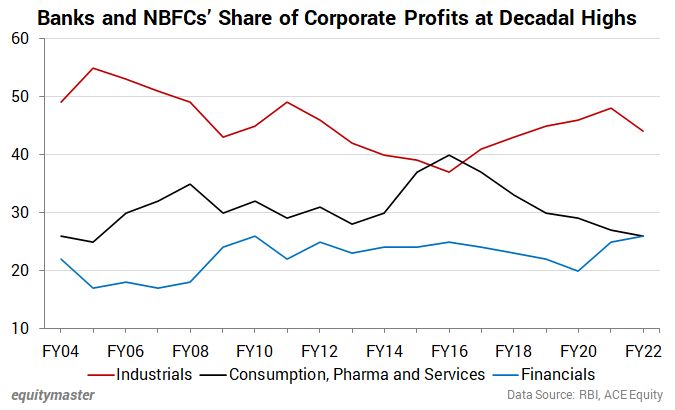Use This Key Indicator to Buy Stocks in 2023

In 1970, Asian Paints bought a mainframe computer for Rs 80 m. It thus became one of India's first private companies to own one.
Since then, the company has digitised its inventory and billing management, which helped save time and costs.
By the end of the decade, Asian Paints started using computerised colour tinting machines. The company also trained employees to use personal computers in the 1980s and established a customer care helpline in the 1990s.
From centralised order booking to supply chain management to storage and retrieval systems were automated in 2008.
So, for more than 50 years, Asian Paints has been collecting data on the colour, size, and quantity of paints purchased all over India. They continue to store proprietary data on paint demand for each neighbourhood. This allows the company to predict paint demand well in advance.
--- Advertisement ---
Investment in securities market are subject to market risks. Read all the related documents carefully before investing
Our Research Hints at a Potential Massive Bull Run in...
Our research has identified the possibility of 3 powerful forces combining this election year.
If things progress as our research suggests... then we could see a potential massive bull run in bluechip stocks over this decade.
We have already identified our top 2 stocks to ride this opportunity.
We will highly recommend you get all the information about this emerging opportunity as soon as possible.
Get Full Details Here
Details of our SEBI Research Analyst registration are mentioned on our website - www.equitymaster.com
---------------------------------------------------
Recently, the company implemented state-of-the-art automatic truck-loading systems in the two new plants at Mysuru and Visakhapatnam. They also use advanced artificial intelligence (AI) and machine learning (ML), to constantly improve the overall demand forecast.
I now see several companies going the Asian Paints way.
Yes, it's true. More than two thirds of the listed companies in India have been undertaking technology-led capex over the past few years. Even the RBI capex data and company annual reports point to this fact.
There is a sharp increase in the share of intangible assets (other than goodwill) in the balance sheets. And the rise in the share of R&D expenses has hardly been witnessed earlier.
Sceptics may want to dismiss these data points as one-offs in the post pandemic recovery phase. But they couldn't be more wrong.
Here again, there are several data points that suggest the capex will continue. More so, the technology related ones.
First of all, India's corporate profits to GDP at 4.5% is currently at a decade high. Though last seen in 2012, the sharp rise in earnings is backed by healthy balance sheets rather than macro tailwinds.
Average operating margins, currently at 16.7%, were last seen in 2005. The average net margin of 8.7% was last crossed in 2011.As companies were left loaded with debt in the previous capex cycle, there were few capacity additions in the past decade.
This time around, India's corporate debt to GDP ratio, at about 60%, is significantly lower than the global average.
Neither have companies splurged on expensive inorganic growth. Nor have they kept their balance sheets leveraged. On the contrary, most chose to get leaner during the pandemic by paying off debt obligations.
What is more, the lenders themselves are in good financial health. Not just private sector, but even public sector banks have seen profits soar in the past few quarters.

Therefore, even as the world grapples with high interest rates, both Indian corporates and their lenders are well equipped to take the risks in their stride. Major systemic risk due to the capex boom is almost ruled out.
Rather, the onset of the capex boom (both technological and physical) could take the share of corporate profits to GDP even higher in the coming decade.
Make: Your Investing Stress-free with Value for Money Stocks
In other words, the earnings per share, or the denominator of your P/E ratio, could go up. This means stocks could start looking cheaper.
So, as an investor, the least you could do is ensure the companies you own are doing their bit in riding the capex boom. They should not only be allocating their capital judiciously but also use the rise in cash flows and profits to build up capacities.
Doing this will ensure that your stocks offer no negative surprises in earnings in 2023 and beyond.
Warm regards,

Tanushree Banerjee
Editor, StockSelect
Equitymaster Agora Research Private Limited (Research Analyst)
Recent Articles
- Should You Worry About HUL's Lost Decade Again? May 7, 2024
- Despite the lost decade, the company trumped most peers in returns over 24 years.
- Can You Double Your Money in HDFC Bank and Kotak Mahindra Bank? May 6, 2024
- Can the stocks of HDFC and Kotak Mahindra Bank double from here? Find out...
- A Simple Hack to Beat the Big Investors for Multibagger Gains May 3, 2024
- Forget the earnings season. Here's is a better metric that could offer interesting insights about stocks.
- How to Invest in Indian Semiconductor Stocks May 2, 2024
- Is this the right time to invest in semiconductor stocks?


Equitymaster requests your view! Post a comment on "Use This Key Indicator to Buy Stocks in 2023". Click here!
Comments are moderated by Equitymaster, in accordance with the Terms of Use, and may not appear
on this article until they have been reviewed and deemed appropriate for posting.
In the meantime, you may want to share this article with your friends!